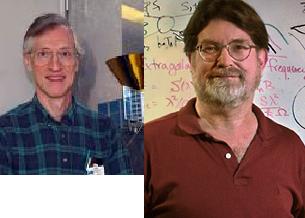The American scientists John Mader and George P. Smoot won the Nobel Prize in Physics for 2006. They were honored for the discovery of black body radiation and the cosmic background radiation or "ancient light" of the universe
Avi Blizovsky

The American scientists John Mader and George P. Smoot won the Nobel Prize in Physics for 2006. They were honored for the discovery of black body radiation and the cosmic background radiation. The background radiation, or "ancient light" of the universe is everywhere and it comes from a time when the universe was 300 thousand years old. The scientists say that certain properties of the cosmic background radiation tell about the evolution of the universe.
Mader, 60, is a senior astrophysicist at NASA's Goddard Space Center and Smoot, 61, is a professor of physics at the University of California, Berkeley. The years were spent working on the Cosmic Background Explorer satellite project, launched by NASA in 1989. It performed the first accurate measurements of the cosmic background radiation. The studies carried out by the two and other scientists using the satellite unequivocally proved the validity of the big bang theory. The background radiation is actually the echo of the Big Bang - the event that created the universe less than 14 billion years ago. This is the radiation created when the universe cooled enough to allow hydrogen atoms to exist. Earlier, the universe was so hot that radiation and matter were unified and the universe was essentially opaque.
NASA launched the Kobe Cosmic Background Explorer telescope in 1989
According to the theory, 380 thousand years after the big bang, matter and radiation split and stars and galaxies began to form. The radiation spread and cooled. The background radiation shines today as weak radio radiation in the microwave range. The Kobi satellite showed that the cosmic background radiation profile follows a predicted pattern known as a blackbody curve. Kobi mapped the tiny differences in temperature in the radiation of the rupture. These small differences represent the primordial distribution of matter. The records provide information about the age of the universe, its geometry and its fate.
This is radiation whose average height is 2.725 degrees above absolute zero, and as mentioned, it glows in the microwave range of the electromagnetic spectrum. Mader's group in Cuba showed that the temperature profile of the background radiation follows a precise pattern in the energy spectrum - known as a blackbody curve. The existence of such a profile was one of the predictions for the confirmation of the Big Bang theory. The satellite also detected small variations in temperature - this result was discovered by Smoot's team. These small reefs contributed to the first structures formed in the universe - the seeds of galaxies appearing in the giant clouds of hot gas that previously filled the entire young universe.
Astronomers believe that the cosmic background radiation contains a lot of information about the origin of the universe, and why the structure we see around us today looks the way it does. They also train that the background radiation holds clues to the end of the universe which now seems to spread forever.
In 2001, NASA launched a satellite to continue Kobe's work - WMap, which examines the cosmic background radiation in even more precise detail.
